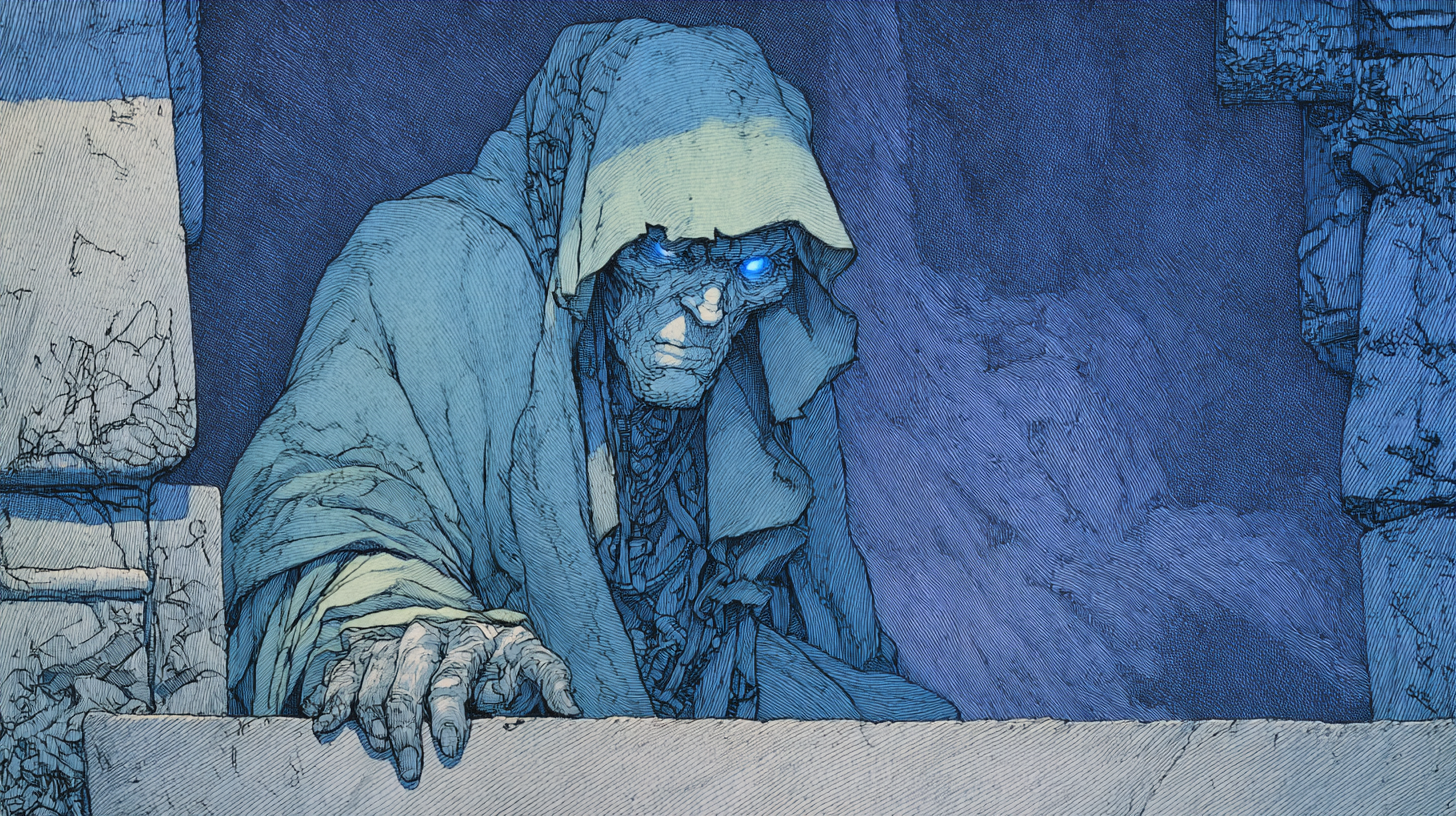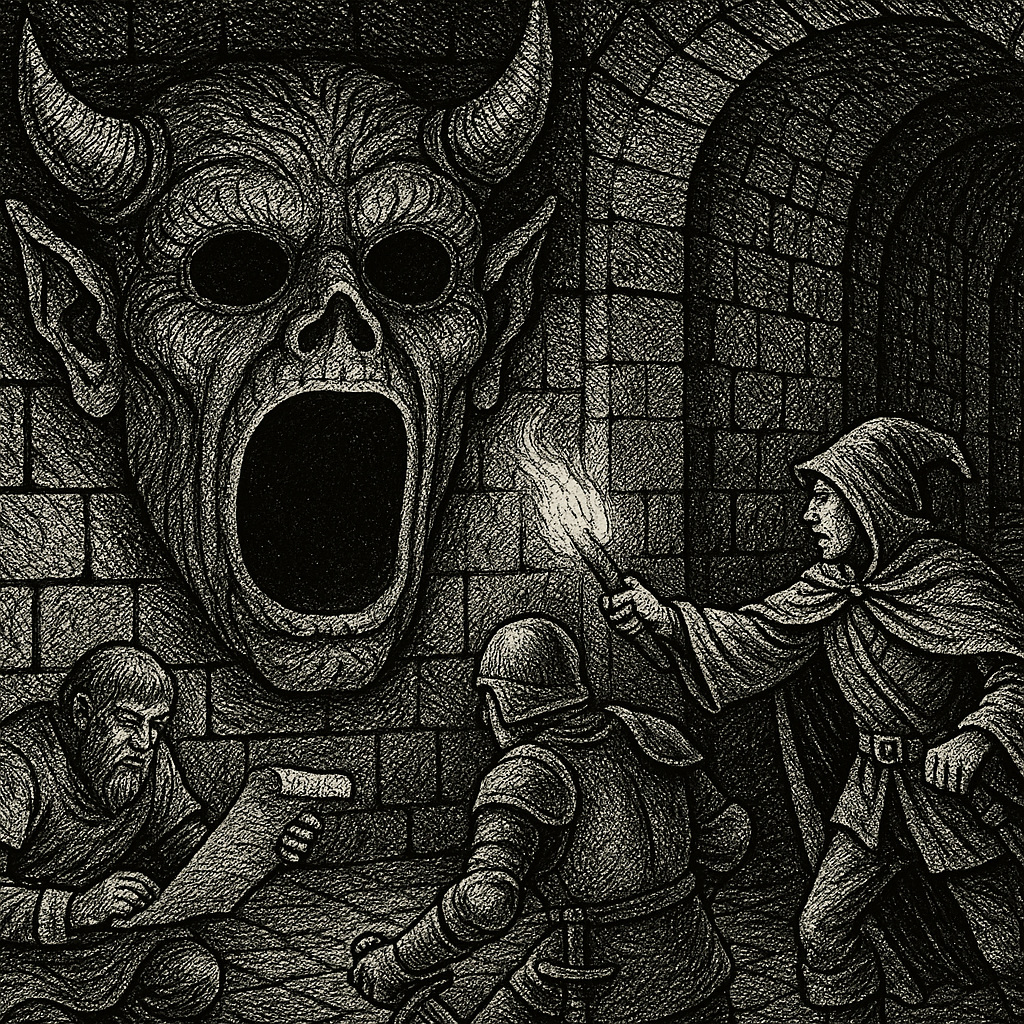
Most of us learn to read a dungeon like a stronghold or a vault: a place where monsters live or treasure hides. But some of D&D’s most famous modules refuse to behave like living spaces at all. They behave like machines—purpose-built, predatory, hungry. Their aim isn’t to be inhabited. Their aim is to kill you.
This isn’t a bug in the lineage; it’s a design philosophy. Once you start reading “dungeon as trap,” the modules snap into focus and your table play sharpens. The mechanical rewards that tempt players forward become narrative teeth. The map becomes a mechanism.
Gary Gygax’s Tomb of Horrors (tournament version c. 1975; TSR module 1978) is the ur-text for the idea. Acererak didn’t build apartments; he built a harvester.
First, the bait. The adventure leads with a riddling poem and rumors of fabulous wealth. Almost every correct choice is framed by one or more exquisitely tempting wrong ones. The dungeon flatters your curiosity, then fines you for it.
Second, the non-ecology. There aren’t bustling factions or guard rotations. There are engineered hazards: the green devil face concealing a Sphere of Annihilation, corridors that lie, archways that teleport you into soft-resets or strip your resources, and a false crypt that feeds your greed before punishing it. None of this supports life. All of it supports failure.
Finally, the predatory climax. Acererak isn’t a janitor of loot; he’s a demilich who devours souls via gem-traps. Your magic items, your hit points, even your body—these are bait and ballast. The real prize is your soul.
A quick rules note strengthens the point. In 1e, XP for treasure (roughly 1 XP per GP) is awarded to player characters, not to monsters or NPCs. Acererak doesn’t “level up” by collecting coins; he grows powerful by eating souls and hoarding the magic of the fallen. Mechanically, players are rewarded for pressing deeper. Fictionally, Acererak weaponizes that incentive.

A cluster of classics share Tomb’s ancestry: built for convention play, calibrated to test problem-solving under pressure rather than simulate a habitat.
In Hidden Shrine of Tamoachan (C1), the poisoned air is a ticking clock. You are losing by lingering. The rooms speak in puzzles and statues and linguistic riddles—all with that tournament glint of “figure it out or pay.”
Ghost Tower of Inverness (C2) makes the disguise thin as tissue. It’s structured for competitive play with discrete challenge rooms and even scoring. It’s a machine for measuring player choices, not a warren for residents.
White Plume Mountain (S2) revels in funhouse logic. Frictionless corridors, boiling bubble chambers, and theatrical set-pieces guard three signature weapons—Blackrazor, Whelm, and Wave. The charm isn’t an orc barracks. It’s a carnival of contrived challenges daring you to touch the hot stove.
In each, the room exists to spring a lesson about caution, lateral thinking, and appetite for risk. The dungeon is an exam with elaborate props.
The deathtrap dungeon didn’t die with bell-bottoms.
Rappan Athuk brands itself the Dungeon of Graves. Even the signage—“Don’t go down the well”—is predatory misdirection. You know exactly what you’ll do next, and the dungeon knows you know.
Dead in Thay reframes the idea as logistics: the Doomvault is a grid of interlocking kill-zones keyed to glyphs and passwords, essentially a facility for processing intruders.
Tomb of Annihilation pays explicit homage. The Tomb of the Nine Gods is lethal puzzle-architecture stuffed with trickster spirits, rotating rooms, and escalation built to serve a setting-wide death curse. Not a home. Not a hoard. A mechanism.
When you encounter a dungeon, ask what it wants. A lair wants stability; a trap wants contact.
Bait with no back-of-house is the tell. Treasure sits in display cases, rumors are rich, even a riddle-poem greets you at the threshold—but there are no kitchens, no latrines, no supply lines. Resetting contraptions—teleport loops, sliding walls, rotating cubes—serve to reshuffle your route, not to sustain inhabitants. Hazards drain spells, hit points, equipment, and time before the “real” fight, turning attrition into the boss’s opening act. Themes skew contrived: color-coded keys, mirrored halls, rooms that teach or tempt rather than house anyone. And victory looks like extraction. You leave alive with knowledge or a singular artifact. You don’t plant a flag and take the lease.
Once you see those signals, you know the contract you’re signing at the table: this isn’t about sacking a fortress; it’s about outwitting a machine.
Because the dramatic contract is clean. Every choice becomes an argument between caution and curiosity, prudence and pride. Early D&D’s XP-for-gold nudges you to “poke the bear.” Deathtrap design weaponizes that compulsion—press deeper and prosper, or press deeper and perish. Fifth Edition nods along with attrition-based tension and puzzle-gated progress that tickle the same nerve endings.
And beneath the mechanics is myth. The labyrinth is an archetype. It is not neutral terrain; it is a hungry shape. From Theseus to Dante, we descend into designed danger where the walls themselves are the foe and the builder is a theologian of malice. The dungeon seeks your soul. That’s the point.
Compare with lair-driven classics—Keep on the Borderlands’ Caves of Chaos or Against the Giants. Those adventures live on factional play, supply lines, guard habits, kitchens and kennels. You can foment betrayals, starve out a wing, choke a tunnel. They’re living spaces. The difference highlights the trap-dungeon’s strangeness: it doesn’t want to be conquered; it wants to be solved without being swallowed.
Begin with purpose: what is your dungeon harvesting—souls, secrets, time, memory, faith? Then align the bait and the teeth. Offer rumors, relics, poems that point inward. Build rooms that reset and re-route. Let hazards nibble resources before the decisive moment. Reward escape with a singular truth or artifact—and make that escape a choice the players have to recognize and seize.
If you want a theological throughline, make the dungeon a parody of sacrament: outward signs that promise grace while inwardly delivering judgment. Acererak’s gems are a dark catechism—confession, communion, consumption. In a world tilted toward hope, a trap-dungeon is the anti-cathedral. It catechizes the proud and feeds on the unrepentant.
Some iconic D&D dungeons are not homes and not hoards. They are predatory architectures designed to lure, test, and consume adventurers—machines with a mythic appetite. Read them that way and the table stops arguing about “where are the latrines?” and starts savoring the real game: recognizing the bait, counting the cost, and choosing when to turn back.
The treasure is bait. The soul is the treasure.


